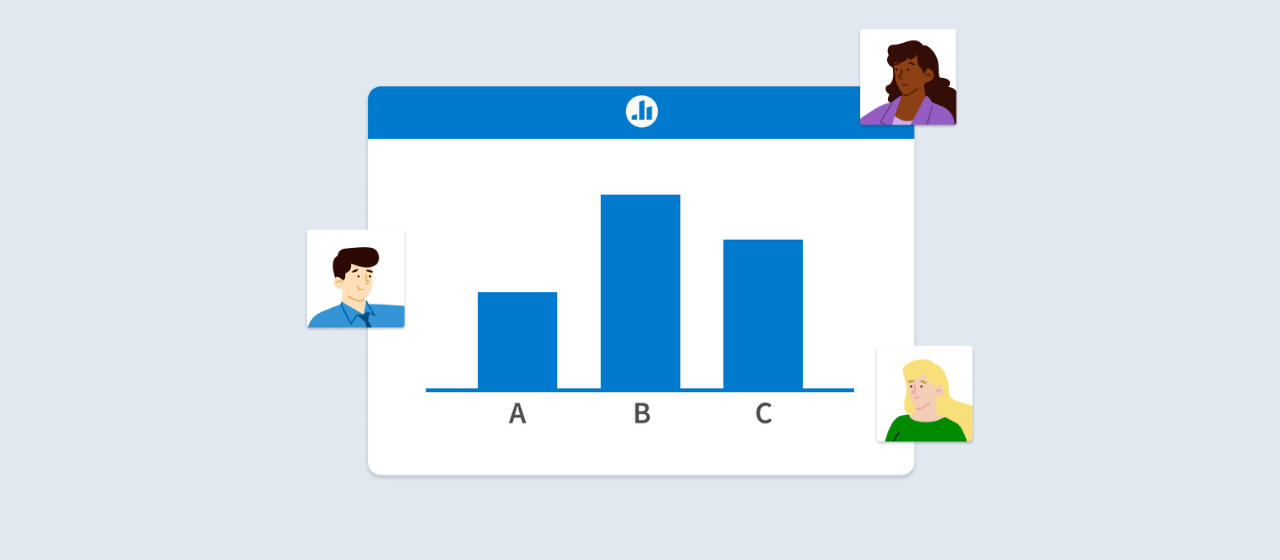Achievement Tests: Definition, Types & Best Practices for Educators

Achievement tests play a massive role in the education system. Many institutions use these tests to determine if the curriculum has achieved its educational outcomes, if instructional methods are working, and if students are absorbing what’s being taught.
While these tests are a key part of every educational institution's curriculum, that doesn’t mean they’re foolproof. They can be riddled with bias and design inaccuracies that prevent you as the assessor from getting the full picture of what your students are learning.
In this article, we’ll explore the origins of this test format, the various types of tests you can administer, and best practices to conduct fair assessments.
What are achievement tests?
Achievement tests are a type of standardized assessment format that are used to test an individual’s knowledge, skill, and proficiency in specific subjects.
In the United States, the Scholastic Aptitude Test (SAT) and American College Testing (ACT) are the most common examples of achievement tests for high school, homeschool, or pre-university students. Such tests aim to assess the potential or the cognitive ability of students to perform certain tasks.
For instance, if you’re taking a driving test, your instructor will expect you to perform certain tasks before you’re granted a license.
From an educator’s perspective, achievement tests are a way to determine if students have attained a certain knowledge level or need additional support. These tests are an excellent way to determine if the curriculum aligns with the learning outcomes. Plus, such tests give educators a system to make standardized comparisons—helping them identify top performers and students who need extra help.
Origins of achievement tests and their use in education
Achievement tests were initially conceptualized in the early 1800s as IQ tests, which acted as a precursor to achievement tests. Alfred Binet, a French psychologist, wanted to create a method to test intelligence. Through a partnership with Stanford University, the Stanford-Binet Intelligence test was introduced to do the same.
Soon after, written achievement tests started taking over formal oral assessments after Horace Mann, the chairman of the Boston Public School Committee at the time, realized that the results were reproducible, making them commonplace in the US.
The shift from oral to written assessments happened because America’s universal schooling policies brought in immigrants from around the world. As public schools were accessible to all, it meant that every student had an equal opportunity to have access to education. Over the years, this added a strain as population density started increasing. It also meant that schools were under a lot of pressure and had to reorganize their grading systems.
Schools relied on bureaucratic management principles to organize students in classes based on age (the basis for grade levels). This method required standardized testing that objectively tested students’ knowledge accordingly.
Types of achievement tests in education
Depending on the method of testing, there are several types of achievement tests:
1. Diagnostic tests
These tests are designed to identify areas of strengths or weakness with respect to subject matter knowledge or skill. Testing occurs before a course or session starts to determine the current level of understanding.
For example, if you’re hosting a session on genomics, you might provide a short multiple-choice questionnaire to determine what students already know. It’ll let you tailor the session to their knowledge gaps, making it more fruitful.
Diagnostic tests are commonly used in personalized learning environments or for creating intervention plans for additional support.
2. Formative tests
Formative tests are given throughout the course of the instructional process. The goal is to monitor student learning, get feedback from students, and provide feedback accordingly.
These are typically low stakes and informal, which means they’re not graded, and students can be more relaxed during the process. For instance, you could conduct a pop quiz after a lecture to check your students’ retention level.
Common examples include quizzes, homework assignments, class discussions, or in-class activities like icebreakers. Insert a Poll Everywhere Activity like a Multiple Choice poll in between your lecture slides to quickly conduct a formative test.
3. Prognostic tests
Prognostic tests are meant to predict future performance in a specific exam or subject. These are common when students take the SAT or ACT. Students take these tests to check if they can hit their target score and realistically plan their college application process.
These are used for academic advising and placement in appropriate courses or support programs. They’re crucial for educators as they help chart a student’s learning path.
4. Accuracy tests
These tests focus on a precise understanding of a topic or the ability to carry out tests with precision. They’re used in contexts where precision is key.
Take, for example, a test that measures grammar knowledge, or an experiment in chemical identification. The rules of grammar are fixed, and chemicals can be identified using their characteristic properties. As such, accuracy tests go beyond theoretical understanding and determine a student’s ability to apply those concepts practically and achieve the same results every time.
Accuracy tests also pinpoint areas where the student might be struggling or misunderstanding, allowing for better intervention to improve learning outcomes.
5. Power tests
Power tests are one of the few testing types that let you remove the time constraint from the exam. Students can take the test without worrying about how much time they need to allocate to each question.
The goal is to test their mastery of the topic—rather than the speed at which they complete the test. It includes questions ranging from easy to extremely challenging to determine the depth of understanding.
These are useful when your students prepare for a university exam or a milestone exam such as the Medical College Admission Test (MCAT).
6. Speed tests
Unlike power tests, speed tests focus on time rather than depth. The tests involve simple questions on a topic or questions that more test-takers can solve quickly.
The results are based on the number of correct answers, showing how quickly students can process information. These tests also show their ability to work under pressure, which is why speed tests are a standard format for examinations in an academic or corporate setting.
7. Summative tests
Summative assessments focus on evaluating student learning or skill acquisition over a set period. These can be, for example, exams at the end of the school year that test students’ knowledge accumulated over the past year.
The main aim is to assess whether a course has met the goals and content standards of the curriculum. These are high-stakes assessments, as they decide the final grade a student receives.
8. Performance-based tests
These tests are used when you want to test specific skills or competencies.
For example, to test students’ ability to present or conduct secondary research, ask them to break down a research paper in a journal club.
The feedback students get in this type of assessment is specific and nuanced, as educators can pay close attention to their performance. It also hones in on the students’ problem-solving, critical-thinking, and creative-thinking skills.
What are the most common controversies surrounding these tests?
Achievement tests have had their fair share of controversy in the education space. Here are some of the most common themes:
Failure to measure capabilities like creative thinking
Many educators believe that achievement tests create a culture of rote learning and don’t speak to a student’s ability to solve real problems.
In an essay, Dr. Terry Meier, the coordinator of the Cooperative Urban Education Teacher Education Program at the Milwaukee Area Technical College, discusses the issue regarding SAT testing.
“The truth of the matter is that far from measuring excellence, standardized achievement tests tend to focus primarily on mechanical, lower-order skills and to reward students’ rapid recognition of factual information,” says Dr. Meier. “Thus, while the president of the College Board glibly asserts that the way to improve minority performance on standardized tests is to improve the quality of their educational experience, teachers are left to confront the reality that what will prepare students to perform well on tests is often in direct conflict with, or simply extraneous to, their real educational needs.”
For example, these tests are not a good indicator of ability in students interested in the creative field. So, testing them based on their ability to memorize facts doesn’t make sense. On the other hand, these tests don’t let you test a student’s ability to connect the dots between theory and practice—at least, not to the student’s fullest ability.
Adds too much pressure on young students to perform
In the Self-Driven Child podcast, Jennifer Wallace, the author of Never Enough: When Achievement Culture Becomes Toxic—and What We Can Do About It discusses the weight we put on students these days. She conducted a parenting study of 6,500 parents across the country with the help of the Harvard Graduate School of Education, finding that 87% of parents wished that childhood was less stressful for kids.
When students are told that their entire future depends on one exam they must take, it adds too much pressure, with many succumbing to it. Many studies have considered the pressure to excel as a factor that negatively impacts adolescent wellness.
This behavior only carries over as students move to professional spaces, worsening their mental health.
Fraught with diversity and equity issues
In 2019, several lawsuits were filed against the University of California for requiring students to submit SAT scores with their applications. The reason? Discriminatory measures.
For years, these exams have been questioned for their ability to test a student’s true potential for academic achievement. While many educators admit that test preparation is vital to acing these exams, many racial and economic minorities can’t access preparation resources.
It explains significant gaps in scores that minorities experience. A 2023 peer-reviewed study even confirmed that predictive bias based on factors such as ethnicity and disability does exist, indicating the need for equitable testing measures.
Similarly, in other situations (like within the classroom) certain groups (such as students with disabilities) might be at a disadvantage.
Not a clear indicator of academic success
Test scores can be influenced by many factors, such as:
- Intellectual ability
- Anxiety
- Societal status
- Access to resources
- Test preparation
- Study environment
- Personal issues
This means a student’s current situation plays a heavy role in their performance. It could lead to misplaced judgment on a student’s capabilities, especially in the long term. And those who don’t score well might miss opportunities due to inaccurate assessments.

Best practices to create fair achievement tests
Here are a few ways in which you can create equitable achievement tests.
Ensure that the test is valid, reliable, and objective
Make sure each of your assessments follow these three principles:
- Validity: The test should accurately measure specific knowledge or skills without being influenced by external factors.
- Reliability: The test results should remain consistent no matter which test-takers take it, indicating that the same attributes are being tested.
- Objectivity: The test results should remain consistent no matter who grades it.
Abiding by these criteria significantly enhances the fairness and inclusiveness of achievement tests.
Supplement achievement tests with other testing measures
Use a combination of testing measures to assess a student’s knowledge level and potential. Don’t rely only on quantitative testing systems.
For example, ask for research presentations, portfolios, and hands-on projects for a holistic view of students’ capabilities. Using a variety of testing measures lets you see which instructional method best suits each student cohort, letting you adjust teaching styles accordingly.
Make accommodations for students with disabilities or special conditions
If you know that certain students have a disability or condition that prevents them from taking assessments under typical conditions, accommodate their needs.
For example, visually impaired students can be given a scribe or Braille-based question papers to help them during the exam. Also, if students from a specific background might be disadvantaged, create programs to provide them with access to the right resources.
Achievement tests still hold their place as long as they’re done the right way
Even though achievement tests have certain drawbacks, they still play a pivotal role in measuring learning outcomes. They also help inform the creation of future instructional strategies by giving educators some direction in the process.
However, if you want to do it the right way, it’s best to keep the principles of testing, such as validity, reliability, and objectivity, in mind. It ensures that you create more inclusive and equitable assessment methods.
You can also achieve this using digital tools like Poll Everywhere that let students take tests on any device while adhering to accessibility standards. Plus, Poll Everywhere isn’t meant only for in-class exams but can also be sent via a link for homework or practical assignments.
If you’re looking for a tool to administer achievement tests, schedule a demo with Poll Everywhere today.

